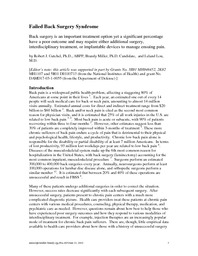
ATTENTION: The works hosted here are being migrated to a new repository that will consolidate resources, improve discoverability, and better show UTA's research impact on the global community. We will update authors as the migration progresses. Please see MavMatrix for more information.
Show simple item record
| dc.contributor.author | Gatchel, Robert J. | |
| dc.contributor.author | Miller, Brandy | |
| dc.contributor.author | Lou, Leland | |
| dc.date.accessioned | 2010-08-11T18:50:18Z | |
| dc.date.available | 2010-08-11T18:50:18Z | |
| dc.date.issued | 2004 | |
| dc.identifier.citation | Published in Practical Pain Management 4:20-31, 2004 | en_US |
| dc.identifier.uri | http://hdl.handle.net/10106/5009 | |
| dc.description | Author's final draft after peer review, also known as a post print. | en_US |
| dc.description.abstract | Back pain is a widespread public health problem, affecting a staggering 80% of Americans at some point in their lives. Each year, an estimated one out of every 14 people will seek medical care for back or neck pain, amounting to almost 14 million visits annually. Estimated annual costs for direct and indirect treatment range from $20 billion to $60 billion. Back and/or neck pain is cited as the second most common reason for physician visits, and it is estimated that 25% of all work injuries in the U.S. are related to low back pain. Most back pain is acute or subacute, with 90% of patients recovering within three to four months. However, other estimates suggest less than 30% of patients are completely improved within 3-months of treatment. These more chronic sufferers of back pain endure a cycle of pain that is detrimental to their physical and psychological health, lifestyle, and productivity. Chronic low back pain alone is responsible for the disability or partial disability of at least 7 million Americans. In terms of lost productivity, 93 million lost workdays per year are related to low back pain. Diseases of the musculoskeletal system make up the 6th most common reason for hospitalization in the United States, with back surgery (laminectomy) accounting for the most common inpatient, musculoskeletal procedure. Surgeons perform an estimated 300,000 to 400,000 back surgeries every year. Annually, neurosurgeons perform at least 100,000 operations for lumbar disc disease alone, and orthopedic surgeons perform a similar number 12. It is estimated that between 20% and 40% of these operations are unsuccessful and result in FBSS. | en_US |
| dc.description.sponsorship | This article was supported in part by Grants No. 3R01 MH046452, 2K02 MH1107 and 5R01 DE010713 (from the National Institutes of Health) and grant No. DAMD17-03-1-0055 (from the Department of Defense) | en_US |
| dc.language.iso | en_US | en_US |
| dc.publisher | PPM Communications, Inc. | en_US |
| dc.subject | Back surgery | en_US |
| dc.subject | Back pain | en_US |
| dc.subject | Chronic low back pain | en_US |
| dc.subject | Spinal surgery | en_US |
| dc.title | Failed Back Surgery Syndrome | en_US |
| dc.type | Article | en_US |
| dc.publisher.department | Department of Psychology, The University of Texas at Arlington | en_US |
Files in this item
- Name:
- Gatchel article millerb-failed ...
- Size:
- 153.4Kb
- Format:
- PDF
- Description:
- PDF
- Name:
- Gatchel article millerb-failed ...
- Size:
- 41.96Kb
- Format:
- Text file
- Description:
- Text
This item appears in the following Collection(s)
Show simple item record


